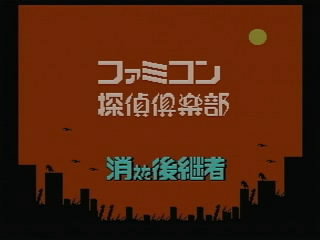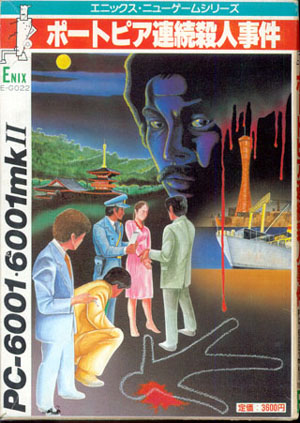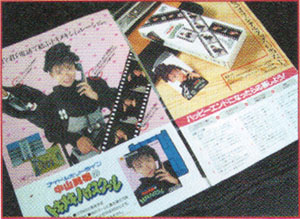Special articles, columns and features exclusive to the MDb.
Famicom Disk System:
The More You Play It, the More You'll Want to Play! [Disk 2]
Introduction | Part 1 | Part 2 | Part 3 | Part 4 | Part 5 | Part 6 | Part 7 | Part 8
WHY THE GAME'S FIRST AND SECOND PARTS CAME OUT ON TWO DISKSAnd what are your feelings regarding the development of The Girl who Stands Behind?Sakamoto: Around the very beginning, it wasn't very interesting. However, there was some hope in the first draft of the story, since at that time, text adventure games like The Portopia Serial Killer Case and The Hokkaido Serial Killer Vanishes in Okhotsk* were popular, but I personally felt those plots weren't interesting. Nevertheless, by telling a story, the other elements of the game were enhanced, and there weren't many half-measures, so I asked my supervisor, "Would it be all right if I put it together in the style of a normal text adventure?" Since the project had been settled, we wondered what to do about the story, and since I also wanted to do it myself, I took up the challenge of writing the scenario. *The Portopia Serial Killer Case and The Hokkaido Serial Killer Vanishes in Okhotsk --> two graphical adventure games made by Dragon Quest's Yuji Horii. Originally, the games were made for the NEC PC-6001 and later to the Famicom. Sakamoto-san, before The Missing Heir, you worked on Tokimeki High School*, right?*Mina Nakayama's Tokimeki High School: Dating simulation for the Famicom Disk System featuring pop idol Miho Nakayama. The game was produced by Square and directed by Final Fantasy creator Nobuo Uematsu. Yoshio Sakamoto was recruited to work on the design. Details of the collaboration are covered in Nintendo of Europe's translation of the Iwata Asks interview with Yoshio Sakamoto and Hironobu Sakaguchi. -Ed. Sakamoto: Yup! (Laughs) Since the development periods overlapped, first I wrote the scenario to The Girl who Stands Behind, then I entrusted it to Osawa... |
|
|
Osawa: When Sakamoto and I make a game, I get the materials of the game from Sakamoto, so there are many games I get stuck working on. Sakamoto will say, "This is what I think," and my job is to report that accurately to the development team. Sometimes, it's like trying to be a translator! (Laughs) Sakamoto: On that note, when I asked Osawa to work on The Girl who Stands Behind, even though I was absorbed with Tokimeki High School, I eventually dragged him into Tokimeki, too! (Laughs) Osawa: Tokimeki High School was made from beginning to end in two weeks! (Laughs) What, two weeks?!Osawa: Once again, it's an unrelated story (Laughs). And it's a secret! Sakamoto: Yet you tell him, "It was made in a short time!" (Laughs) Well, in that case, the work on Tokimeki High School was finished, and yeah, I worked on Famitan. Tokimeki also wasn't really an adventure game, was it? Because of that, I wanted to do one, but there was the problem of time, and there were various other things we couldn't do, so we implemented those in Famitan. What was it you couldn't do?Sakamoto: Make things more dramatic. I get the impression the development cycle of every game is continuous.Sakamoto: That's right. There were players waiting around who would ask, "What will they come out with next?" and in those days, there was a very good connection between creators and players. However, with Famitan, Part 1 and Part 2 were split...Sakamoto: Before that, Shin Onigashima* was also split. *Shin Onigashima: Literally "New Onigashima", a part of the Famicom Fairytales series. The game is loosely based on the famous Japanese fairytales Momotaro and The Bamboo Cutter, and is about a boy and girl with supernatural powers who defeat the ogres (oni) of the island Onigashima (literally "Oni Island"). Shin Onigashima was the first game released in two parts for the Famicom Disk System. |
|
Was that idea of creating games with two disks there when you first started making the Disk System?Sakamoto: I think it was. At any rate, we made the Part 1 and Part 2 as two separate disks, and the player really had to have both disks. We needed to sell it twice! (Laughs) (Laughs). In the commercial, it said something like, "Overwrite with Part 2 and play!" In other words, it was 500 yen.**Famicom Disk System games sold at retail for around 2500 yen, or about $30 in today's money. In contrast, players could go to a Nintendo Kiosk and pay 500 yen (about $6) to write data to an empty disk (or erase and write over existing data). Sakamoto: Though they said that, if you didn't have Part 1, you couldn't play the Part 2.* *The original language here is "First Part" (前編) and "Last Part" (後編). Osawa: However, they were correct in saying, "You can overwrite other games!" (Laughs) Sakamoto: But hold onto Part 1! (Laughs) Osawa: Moreover, after the commercial version of the disk came out, you could only [use the Disk Kiosks to] overwrite about two weeks later. However, the story was, "Until they can overwrite it, it's pointless for players to wait!" (Laughs) There were feelings of, "Quick, let me play!" and, "They'll buy a new game at 2500 yen just to play it one day early!" That was the impression in those days! (Laughs) Now they say that about episodes! (Laughs)Sakamoto: But to tell the truth, we put the system program onto Side A and put the game data onto the part that was left over [Side B -ed.].* However, at any rate, the volume was used to the limit, so if you didn't have both sides, you couldn't play for very long. Side A was really just the data. So, even if you played Part 2, you had to first put in Side A [of Part 1], and it would pull data off. So the story also was, you had to have both disks. Nevertheless, it was another problem of, "It won't go in, it won't go in!" *Disks for the Famicom Disk System were double-sided, like an LP. Smaller games would fit completely onto Side A, and you could take the disk down to a Disk Kiosk and write a game to Side B for 500 yen. Famicom Tantei Club and other games included the program data on Side A and the graphical data on Side B. Note the original language used is "Side 1" (1枚目). You can read more about the Famicom Disk System on N-Sider. Osawa: And that's how it was: whittle down the number of pixels per letter, and I think we whittled them down to 16 bytes apiece. However, when you begin making an adventure like Famitan, you say, "Reduce it so one character = one byte," and you have to try to put it into that highly-constrained world. (Laughs) We would say, "If we took out this many characters, how many bytes will be cut out?" And that was how we did it in those days. Sakamoto: Even though we put it on disk, it was also difficult to adjust so it would go into all the RAM. |

Flyer for Famicom Detective Club: The Missing Heir. Source: Game Industry Glossary Game Flyer Collection (Japanese). |
|
Osawa: As for the text displayed in the first area, when we read all the RAM at once (32KB for the program and 8KB for the data -Ed.), it said, "I can't read the whole thing." So, if you take, "I did it...." for example, you could decrease the four dots after "I did it" to three! When we did that, all the single bytes we cut out added up, and as a result, we reduced it by 100 bytes! (Laughs) In that manner, every day we fought with the numbers. Sakamoto: Even though we said, "It'll never go in!" we just exchanged that for, "Go in! Sooner or later, it'll go in!" (Laughs) Osawa: We changed the wording. For instance, if you change "to be" to "is", you can shorten it by three bytes. Sakamoto: In that fashion, we'd cut the text in half, but our Japanese slowly got very strange! (Laughs) I clearly remember with The Girl who Stands Behind, the phrase, "I have respect for my father," was too long, and I meant to write, "I respect my father", but I forgot to take out a particle, so it read "I respect boobs", and then it became a little sexy! (Laughs)* Osawa: And that's how you write formal language! (Laughs) *The original Japanese phrasing was, "わたしは ちちのことを そんけいしています." Sakamoto changed the phrasing to, "ちちをそんけいしています", but forgot to leave out the particle "の" from the original, and got, "ちちのを そんけいしてます." An English equivalent of this kind of mistake might be changing, "I have respect for my father," to "I respect my pop," but misspelling it as, "I respect my poop." |

Title Screen to Famicom Tantei Club: The Missing Heir. |
Introduction | Part 1 | Part 2 | Part 3 | Part 4 | Part 5 | Part 6 | Part 7 | Part 8












